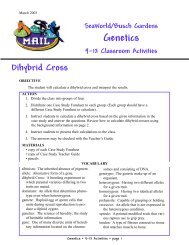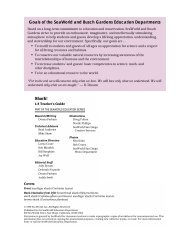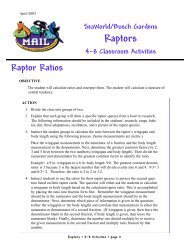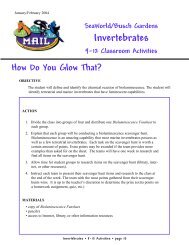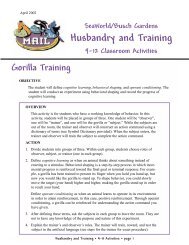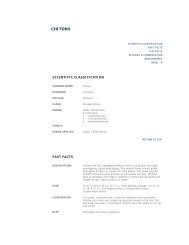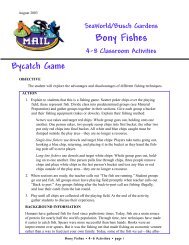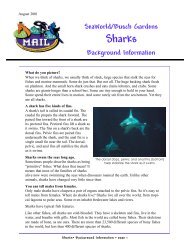Create successful ePaper yourself
Turn your PDF publications into a flip-book with our unique Google optimized e-Paper software.
<strong>OCTOPUS</strong><br />
SCIENTIFIC CLASSIFICATION<br />
COMMON NAME: octopus<br />
KINGDOM: Animalia<br />
PHYLUM: Mollusca<br />
CLASS: Cephalopoda<br />
SUBCLASS: Coleoidea<br />
ORDER(S): Octopoda<br />
FAMILY:<br />
GENUS SPECIES: About 200 species<br />
FAST FACTS<br />
SCIENTIFIC CLASSIFICATION<br />
FAST FACTS<br />
FUN FACTS<br />
ECOLOGY & CONSERVATION<br />
BIBLIOGRAPHY<br />
MENU - A<br />
RETURN TO TOP<br />
DESCRIPTION: Octopuses have a short, round body. They have eight tentacles<br />
(arms) jointed by a web of skin. The arms are lined with rows of<br />
suckers from the base to the tip. The mantle (body) surface is<br />
either smooth, or covered with wart-like projections or cirri.<br />
SIZE: The smallest octopuses are the “pygmy” octopuses, which are only<br />
about 2 cm (0.79 in.) long and weigh less than 1 gram (0.04 oz.).<br />
Octopuses can grow to be much larger; Arm lengths of 10 to 15 m<br />
(32.8–49.2 ft.) long have been observed.<br />
LOCOMOTION: Unlike other molluscs, octopuses are capable of high-speed<br />
swimming. They use water-powered jet propulsion—in which water<br />
is expelled from the mantle cavity—to swim and use their suckerlined<br />
arms for crawling. Since octopuses have a more benthic<br />
lifestyle, crawling is more commonly seen than swimming.<br />
DIET: Primarily crabs and clams<br />
FEEDING: Octopuses are active, predatory carnivores. Some octopuses hunt<br />
“blindly” by “tasting” underneath rocks with their suckers. Some
species have a radula modified as a drill to bore through mollusc<br />
shells. Octopuses also have a pair of beak-like jaws used for biting<br />
and tearing. They also posses a pair of poison glands to paralyze<br />
prey for easier consumption.<br />
Octopuses either leave their dens to hunt or wait near the<br />
entrance of their lair. Prey is taken back into the den and the<br />
shells and skeletons are discarded at the entrance, creating an<br />
“octopus’ garden.”<br />
REPRODUCTION: Octopuses are either male or female. Fertilization is internal. Males<br />
have a modified arm, called a hectocotylus, which is spoon-shaped<br />
and used to deposit sperm in the mantle cavity of the female. Eggs<br />
are deposited and protected by the female.<br />
RESPIRATION: Octopuses have two gills that are used for gas exchange. Water<br />
circulation through the mantle provides oxygen for the gills.<br />
LIFE SPAN: About 1 to 5 years; Most octopuses die shortly after a single<br />
spawning.<br />
RANGE: Oceans worldwide<br />
HABITAT: Benthic; often in dens located in crevices or holes.<br />
FUN FACTS<br />
RETURN TO TOP<br />
1. The blue-ringed octopuses of Asia, Australia, and the western Pacific Ocean are the<br />
deadlist cephalopods. All octopuses have large poison glands that paralyze prey.<br />
However, in the blue-ringed octopuses, the chemicals in the saliva are more potent.<br />
These octopuses have been responsible for a few human fatalities and numerous near<br />
fatalities. The danger of these octopuses was not discovered until the 1950s. Blueringed<br />
octopuses are generally timid and will avoid people. However, they will bite<br />
when they are being harassed or threatened.<br />
2. The veined octopus, Octopus marginatus, lives on sand and in mud, emerging at dusk<br />
and dawn to feed. These can be dangerous habitats due to the exposure and little<br />
protection from predators. One way this species gains more protection is to hide within<br />
mollusc shells. However, near human settlements this octopus is likely to be found in<br />
discarded coconut shells. When the halves of coconuts are fitted together, they make<br />
a great shelter that is difficult for fishes or humans to open.<br />
3. Octopuses have chromatophores (color cells) covering their body which are<br />
responsible for their coloration. Chromatophores are controlled by the nervous system<br />
and hormones. The contraction and expansion of these cells creates changes in color.<br />
When disturbed, an octopus may display a defensive color pattern. Color changes are<br />
also associated with courtship behaviors. Color changes may be accompanied by<br />
changes in skin texture.<br />
4. Octopuses posses a large ink sac, with glands that secrete a brown or black fluid.<br />
When alarmed, the octopus releases ink from the mantle cavity into the surrounding<br />
water, hopefully confusing predators.<br />
5. The eyes of octopuses are highly developed compared to other molluscs and very
similar to those of fishes. They have a lens which can control the amount of light<br />
entering the eye. They are capable of forming an image and experiments have shown<br />
that octopuses can discriminate objects as small as 0.5 cm from 1 m away.<br />
6. The common name of the mimic octopus, Thaumoctopus mimicus, comes from its<br />
ability to impersonate the shape and behavior of other animals, usually venomous<br />
ones. Impersonations include flatfishes, lionfish, and sea snakes. When impersonating<br />
a sea snake, the octopus raises its arms and moves them to simulate snake-like<br />
motion.<br />
7. For more information, please visit the Tide Pool Infobook.<br />
ECOLOGY AND CONSERVATION<br />
RETURN TO TOP<br />
Octopuses are extremely popular as food all around the world. They are harvested<br />
recreationally, on a small scale, and through large commercial fisheries. Octopuses account<br />
for approximately 10% of the world cephalopod catch. Fisheries must be regulated in order<br />
to conserve octopus populations.<br />
Beachcombers, tidepoolers, and divers must remember not to disturb or collect any<br />
specimens that they may encounter. The removal of animals from an ecosystem may disturb<br />
ecological processes and decreased the diversity in areas that are frequently visited. Because<br />
of their specific nutritional and physiological needs, certain animals, such as octopuses have<br />
a much better chance for survival in their natural environment than in an unregulated home<br />
aquarium.<br />
BIBLIOGRAPHY<br />
RETURN TO TOP<br />
Buchsbaum, M. R. a. P., Vicki & John. (1987). Living Invertebrates. Pacific Grove, CA, The<br />
Boxwood Press.<br />
Morris, R. H., D. p. Abbott, et al. (1980). Intertidal Invertebrates of California. Stanford,<br />
Stanford University Press.<br />
Myers, P., R. Espinosa, C. S. Parr, T. Jones, G. S. Hammond, and T. A. Dewey. 2006. The<br />
Animal Diversity Web (online) <br />
Ruppert, E. E. and R. D. Barnes (1994). Invertebrate Zoology. San Diego, Harcourt Brace<br />
College Publishers.<br />
RETURN TO TOP
RETURN TO PREVIOUS PAGE






